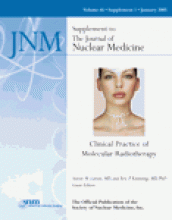Abstract
A new treatment modality for inoperable or metastasized gastroenteropancreatic tumors is the use of radiolabeled somatostatin analogs. Initial studies with high doses of [111In-diethylenetriaminepentaacetic acid (DTPA)0]octreotide in patients with metastasized neuroendocrine tumors were encouraging, although partial remissions were uncommon. Another radiolabeled somatostatin analog that is used for peptide receptor radionuclide therapy (PRRT) is [90Y-1,4,7,10-tetraazacyclododecane-N,N′,N″,N‴-tetraacetic acid (DOTA)0,Tyr3]octreotide. Various phase 1 and phase 2 PRRT trials have been performed with this compound. Despite differences in the protocols used, complete and partial remissions in most of the studies with [90Y-DOTA0,Tyr3]octreotide were in the same ranges, 10%–30%; these ranges were higher than those obtained with [111In-DTPA0]octreotide. Treatment with the newest radiolabeled somatostatin analog, [177Lu-DOTA0,Tyr3]octreotate, which has a higher affinity for the subtype 2 somatostatin receptor, resulted in complete or partial remissions in 30% of 76 patients. Tumor regression was positively correlated with a high level of uptake on OctreoScan imaging, a limited hepatic tumor mass, and a high Karnofsky performance score. Treatment with radiolabeled somatostatin analogs is a promising new tool in the management of patients with inoperable or metastasized neuroendocrine tumors. Symptomatic improvement may occur with all 111In-, 90Y-, or 177Lu-labeled somatostatin analogs that have been used for PRRT. The results obtained with [90Y-DOTA0,Tyr3]octreotide and [177Lu-DOTA0,Tyr3]octreotate are very encouraging in terms of tumor regression. Also, if kidney protective agents are used, the side effects of this therapy are few and mild, and the duration of the therapy response for both radiopharmaceuticals is more than 2 y. These data compare favorably with those for the limited number of alternative treatment approaches.
Footnotes
Received May 11, 2004; revision accepted Aug. 13, 2004.
For correspondence or reprints contact: Dik J. Kwekkeboom, MD, Department of Nuclear Medicine, Erasmus Medical Center, University Hospital Rotterdam, Dr. Molewaterplein 40, 3015 GD Rotterdam, The Netherlands.
E-mail: d.j.kwekkeboom{at}erasmusmc.nl







